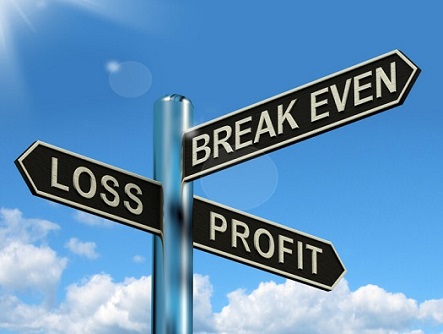- 7 creative options to increase your working capital - February 17, 2020
- 7 common myths about selling your business - February 6, 2020
- Why you should focus on existing customers rather than new ones - February 6, 2020
In our experience most businesses consider the analysis or knowledge of a break-even point within their business something that a management consultant might discuss with them but not something they need to understand themselves.
We feel this exercise is key in understanding the health of your business and how to manage the expansion (or retraction) of your business as required.
The obvious nugget of information that knowing your break-even point would show is whether your business is currently profitable, which is likely you will already know, but it provides much more than that which we will explain here.
What is a break-even point?
This is the point at which the sales in the business covers the fixed costs of the business. Fixed costs are those which don’t change irrespective of the amount of sales or units of a product sold.
We feel this is more easily understood if we break down businesses into 2 broad areas:
- Product based business (i.e. a business that sells a particular product or products)
- Service based business (e.g. an accountant, architect or solicitor who provides a service)
Product-based business:
The break-even point will show a business how many of a particular product/s needs to be sold to break-even. Beyond this point the business will be profitable.
This figure is calculated by dividing the total fixed costs of production by the price of a product per individual unit less the variable costs of production.
It is important to also note here that a variable cost is one that changes when sales change. When you sell more items, your variable costs increase. Examples of variable costs include direct materials, direct labour, and transaction costs like postage and packaging etc.
To be able to perform this calculation, you will need to make the distinction between fixed and variable costs within your business.
Let’s look at a simple example to understand how this works:
Example: A toy manufacturer is calculating their break-even point:
Financial Inputs:
Fixed Costs = £4,500/month
Variable Costs = £10/unit
Sales Price Per Toy = £20
Break-even Point in Units = Fixed Costs / (Sales Price Per Unit – Variable Costs Per Unit)
= £4,500 / (£20 – £10)
= £4,500 / £10
= 450
This calculation provides us with the answer that the toy manufacturer needs to sell 450 toys each month to break-even.
Break-even analysis then looks at the level of fixed costs relative to the profit earned by each additional unit produced and sold. Put simply a business with a lower level of fixed costs will have a lower break-even point. We looked at methods for reducing costs in your business in a separate article.
Service-based business
The complication in calculating a break-even is that the business doesn’t have a physical product to sell like a retailer or manufacturer.
The first step is to identify your business unit. For example, a consultancy-based firm bills their customers by the hour and an accounting firm charges by a tax return or suite of services, a training company sells courses, and other businesses might have a fixed price per customer, also known as value-based pricing.
In each case, they are all seeking to find out how many units (hours, tax returns, clients) they need to reach break-even.
Let’s look at a simple example for a service-based business to understand how the calculation will work:
Example: An accounting firm is calculating their break-even point
Financial Inputs:
Unit of Measure: Chargeable Hours
Total Fixed Costs: £85,000
Selling Price/Hourly charge out rate: £125 per hour
Variable Cost: £57 per hour
The Break-even point: = Fixed Costs / (Selling Price – Variable Cost)
= £85,000 / (£125 – £57)
= 1,250
Therefore, the business needs 1,250 chargeable hours each year to break-even.
A subsequent calculation which can then be performed on the basis of the above, for a service-based business, is a capacity check. (i.e. can the business support/have the employees to deliver 1,250 hours)
Simply calculate the number of productive hours that your current employees can work in a year. (i.e. 1 employee may work 38 weeks @ 40 hours week = 1520 hours. If 90% of this time is productive/billable time this equals: 1520 x 90% = 1368 hours)
If this calculation provides a figure is more than the 1250 hours (as above) then the business has the capacity to provide this many hours.
If it is less, then the business will need to hire more staff to deliver this level of business income.
Not that this increased staffing cost will then change the fixed costs of the business and the break-even calculation will need to be redone.
It is important to recalculate your break-even point with any major change in your fixed costs. Another example is that you may move premises, to a larger facility in increase production and supply of your product or service. If in doing so you are now paying more rent then you would need to sell more units/of your service to break-even. This is important to understand and even more important to calculate and analyse regularly as this will likely inform some better strategic decisions in your business.
At RCP we have helped many businesses with break-even calculations in order to inform their business decisions to help them grow or achieve more when they come sell.
Please get in touch with us to see how we can assist you and your business.

